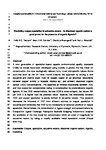Predicting copper speciation in estuarine waters – Is dissolved organic carbon a good proxy for the presence of organic ligands?
| dc.contributor.author | Pearson, HBC | |
| dc.contributor.author | Comber, Sean | |
| dc.contributor.author | Braungardt, Charlotte | |
| dc.contributor.author | Worsfold, Paul | |
| dc.date.accessioned | 2017-01-20T08:51:19Z | |
| dc.date.available | 2017-01-20T08:51:19Z | |
| dc.date.issued | 2017-01-18 | |
| dc.identifier.issn | 0013-936X | |
| dc.identifier.issn | 1520-5851 | |
| dc.identifier.uri | http://hdl.handle.net/10026.1/8268 | |
| dc.description.abstract |
A new generation of speciation-based aquatic environmental quality standards (EQS) for metals have been developed using models to predict the free metal ion concentration, the most ecologically relevant form, to set site-specific values. Some countries such as the U.K. have moved toward this approach by setting a new estuarine and marine water EQS for copper, based on an empirical relationship between copper toxicity to mussels (Mytilus sp.) and ambient dissolved organic carbon (DOC) concentrations. This assumes an inverse relationship between DOC and free copper ion concentration owing to complexation by predominantly organic ligands. At low DOC concentrations, the new EQS is more stringent, but above 162 μM DOC it is higher than the previous value. However, the relationship between DOC and copper speciation is poorly defined in estuarine waters. This research discusses the influence of DOC from different sources on copper speciation in estuaries and concludes that DOC is not necessarily an accurate predictor of copper speciation. Nevertheless, the determination of ligand strength and concentrations by Competitive Ligand Exchange Adsorptive Cathodic Stripping Voltammetry enabled the prediction of the free metal ion concentration within an order of magnitude for estuarine waters by using a readily available metal speciation model (Visual MINTEQ). | |
| dc.format.extent | 2206-2216 | |
| dc.format.medium | Print-Electronic | |
| dc.language | en | |
| dc.language.iso | en | |
| dc.publisher | American Chemical Society (ACS) | |
| dc.subject | Animals | |
| dc.subject | Bivalvia | |
| dc.subject | Carbon | |
| dc.subject | Copper | |
| dc.subject | Ligands | |
| dc.subject | Water | |
| dc.subject | Water Pollutants, Chemical | |
| dc.title | Predicting copper speciation in estuarine waters – Is dissolved organic carbon a good proxy for the presence of organic ligands? | |
| dc.type | journal-article | |
| dc.type | Journal Article | |
| dc.type | Research Support, Non-U.S. Gov't | |
| plymouth.author-url | https://www.webofscience.com/api/gateway?GWVersion=2&SrcApp=PARTNER_APP&SrcAuth=LinksAMR&KeyUT=WOS:000394724300035&DestLinkType=FullRecord&DestApp=ALL_WOS&UsrCustomerID=11bb513d99f797142bcfeffcc58ea008 | |
| plymouth.issue | 4 | |
| plymouth.volume | 51 | |
| plymouth.publication-status | Published | |
| plymouth.journal | Environmental Science & Technology | |
| dc.identifier.doi | 10.1021/acs.est.6b05510 | |
| plymouth.organisational-group | /Plymouth | |
| plymouth.organisational-group | /Plymouth/Faculty of Science and Engineering | |
| plymouth.organisational-group | /Plymouth/Faculty of Science and Engineering/School of Geography, Earth and Environmental Sciences | |
| plymouth.organisational-group | /Plymouth/REF 2021 Researchers by UoA | |
| plymouth.organisational-group | /Plymouth/REF 2021 Researchers by UoA/UoA06 Agriculture, Veterinary and Food Science | |
| plymouth.organisational-group | /Plymouth/Research Groups | |
| plymouth.organisational-group | /Plymouth/Research Groups/BEACh | |
| plymouth.organisational-group | /Plymouth/Research Groups/Marine Institute | |
| plymouth.organisational-group | /Plymouth/Users by role | |
| plymouth.organisational-group | /Plymouth/Users by role/Academics | |
| dc.publisher.place | United States | |
| dcterms.dateAccepted | 2017-01-18 | |
| dc.rights.embargodate | 2018-1-18 | |
| dc.identifier.eissn | 1520-5851 | |
| dc.rights.embargoperiod | 12 months | |
| rioxxterms.versionofrecord | 10.1021/acs.est.6b05510 | |
| rioxxterms.licenseref.uri | http://www.rioxx.net/licenses/under-embargo-all-rights-reserved | |
| rioxxterms.licenseref.startdate | 2017-01-18 | |
| rioxxterms.type | Journal Article/Review |


